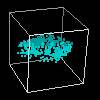
Astronomy and Astrophysics
Home
Home
Links
Glossary
Monday
Tuesday
Wednesday
Thursday
Friday
Create Report
Welcome to Astronomy and Astrophysics at the Shodor Education Foundation!
"Space is big. You just won't believe how vastly, hugely, mind-bogglingly big it is. I mean, you may think it's a long way down the road to the drug store, but that's just peanuts to space. "- Douglas Adams
The Hitchhiker's Guide to the Galaxy
The sizes, distances, times, and amounts we deal with when we deal with space are, well, astronomical. The United States is roughly 2500 kilometers across. The Earth is roughly 13000 kilometers across. The Sun is roughly 100 times as wide as the Earth, and is 150,000,000 km away from the Earth. Pluto, the ninth planet in our solar system, is 40 times as far away from the Sun as the Earth is. The nearest star to the Earth, Alpha Centauri, is 40,300,000,000,000 km away. That is so far that light leaving Alpha Centauri takes 4 years to get to the Earth. The center of our galaxy, the Milky Way, is 248,000,000,000,000,000 km away, and light from the center of the Milky way takes 30,000 years to get to Earth. That means that when we look at the center of the Milky way, we are seeing light that is 30,000 years old. And that's just one galaxy in the entire universe.
I don't know about you, but my car wouldn't make it that far. And I'm guessing no one reading this is a billion years old.
What that means is we are stuck with analyzing the light we collect from the stars, getting a few samples of interplanetary dust in our upper atmosphere, and going to the nearest planets. In order to interpret and analyze the information we collect, we need to apply the laws of science as they are known on Earth, and assume those laws hold throughout the universe. We do this by creating models of what we think the universe is like (theory), using those models to make predictions about what we should see (computation), and comparing the predictions of the models to what we actually see in the universe (observation).
As scientists we use the computer to model what is going on in space, from the insides of stars, to the mechanics of colliding galaxies, to chemical processes on interstellar dust which may have contributed to Earth's primordial soup. This summer we will study the use of computers in astronomy and astrophysics.
The workshop will involve formal lectures, structured hands-on labs and activities, visits by practicing computational scientists, and the opportunity to work collaboratively with other students on a small research project. Careful observations and reporting of those observations will be emphasized at all times.